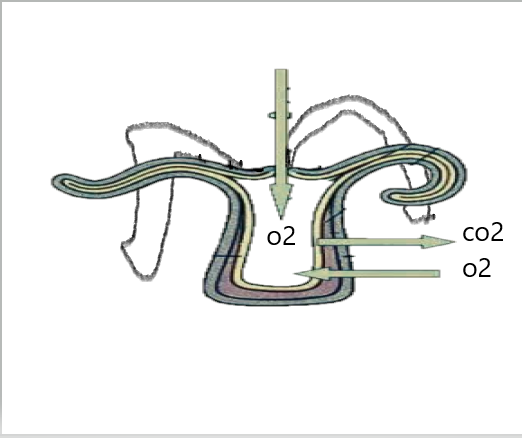ORGANS AND MECHANISM OF RESPIRATION IN LOWER INVERTEBRATES
INTRODUCTION
- Carbon dioxide can be utilized by plant for the process of photosynthesis. Other than that most of animal eliminate carbon dioxide from their body and mostly supplies their tissues and cells with oxygen. Hence respiration is process by which organism supplies oxygen to tissue and cell and eliminate carbon dioxide. It is precise to say by the process of respiration an organism fulfil its need of oxygen.
- In terms of biochemistry respiration is chemical reaction which occur in all living cell that provides energy after breakdown of glucose. Now respiration can be divided into two categories first aerobic respiration and other is anaerobic respiration. In aerobic respiration breakdown of glucose takes place in presence of oxygen amount of energy liberated is more and time consumption is higher as compare to anaerobic respiration. Where as in anaerobic respiration glucose breakdown takes place in absence of oxygen. Here the amount of energy liberates in the form of ATP is less but time needed to perform anaerobic respiration is also less.

PORIFERA
Scypha
- Simple diffusion allow the gaseous exchange between the flowing water and cells of sponges, oxygen dissolve in water diffuses in the cell and bring about oxidation of protoplasmic molecules with liberation of energy which is entrap in ATP. The ATP supplies energy to the metabolising cells.
- There is no especial organ of respiration in sponges.

COELENTERATA
Hydra
- Hydra posses neither blood nor blood vessels, nor any organ for respiration. Hence respiration is carried out by individual cells of the body. As body wall is very thin and there is circulation of water in gastrovascular cavity, most of the cell remains freely exposed to the surrounding water. Therefore exchange of oxygen and carbon dioxide occur directly by diffusion through cell membrane in outer environment.

PLATYHELMINTHES
Fasciola hepatica
- Oxygen content in a bile is extremely low, respiration in liver fluke is usually anaerobic or anoxybiotic.
- In this process glycogen present as a reserve food breaks by anaerobic glycolysis into carbon dioxide and fatty acid. Carbon dioxide diffuses out of the body through general body surface, where as fatty acid get excreted through excretory system. This an exothermic reaction involving release of heat energy. If free oxygen is available aerobic respiration takes place.
Taenia solium
- Respiration of the tape worm is mainly anaerobic or anoxybiotic. Glycogen the principle reserve food and chief source of energy ungergoes glycolysis and producing carbon dioxide and fatty acids. In addition to fatty acid other organic acid like lactic acid are also produce.
- Free oxygen whenever available, is also consumed by tapeworms. Rate of consumption is also maximum in interior proglottid and decline gradually towards the posterior end.

ASCHELMINTHES
Ascaris lumbricoides
- Respiration in their case also is mainly anaerobic or anoxybiotic because the oxygen content of host intestine is generally poor. Here also glycogen undergo glycolysis and break down to produce carbon dioxide fatty acid and energy. The main fatty acid which is produce is valerianic butyric and caproic acids. That are excreted through cuticles and impart foul smell like canned pineapples.
- Aerobic respiration takes place wherever free oxygen is left in host intestine. This indicates presences of small amount of cytochrome in parasites. According to Hyman haemoglobin is present in body cavity and body wall allow transport of oxygen

CONCLUSION
- Different organism posses different mechanism for respiration also their organs for respiration also differ greatly among whole animal kingdom. When discussing about lower invertebrate respiration occur simply through their body wall mostly by the process of simple diffusion.
- In phylum porifera respiration simply occur on the body surface. Through their body surface exchange of gasses takes place. Same scenario can be seen in hydra. The reason behind this is that they posses tissue grade of organisation that are well exposed to surface which allows direct diffusion of gasses.
- In case of platyhelminthes and aschelminthes anaerobic respiration is dominante which is strongly promoted by their parasitic behaviour. As bile and intestine lack free oxygen they produces energy within their body by the means of anaerobic respiration. But anaerobic respiration is not single single mode of respiration in them. Avalaiblity of oxygen allow them to perform aerobic respiration.
- Hence in lower invertebrates respiration is performed by the mean of body wall or integument.
Discover more from ZOOLOGYTALKS
Subscribe to get the latest posts sent to your email.

